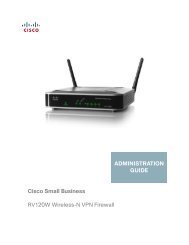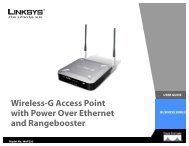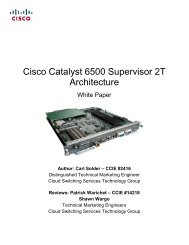Cisco AP541N Dual-band Single-radio Access Point Administration ...
Cisco AP541N Dual-band Single-radio Access Point Administration ...
Cisco AP541N Dual-band Single-radio Access Point Administration ...
You also want an ePaper? Increase the reach of your titles
YUMPU automatically turns print PDFs into web optimized ePapers that Google loves.
5SNMPConfiguring SNMP on the <strong>Access</strong> <strong>Point</strong>Simple Network Management Protocol (SNMP) defines a standard for recording,storing, and sharing information about network devices. SNMP facilitates networkmanagement, troubleshooting, and maintenance. The access point supportsSNMP versions 1, 2, and 3. Unless specifically noted, all configuration parameterson this page apply to SNMPv1 and SNMPv2c only.Key components of any SNMP-managed network are managed devices, SNMPagents, and a management system. The agents store data about their devices inManagement Information Bases (MIBs) and return this data to the SNMP managerwhen requested. Managed devices can be network nodes such as access points,routers, switches, bridges, hubs, servers, or printers.The access point can function as an SNMP managed device for seamlessintegration into network management systems such as HP OpenView.From the SNMP page, you can start or stop control of SNMP agents, configurecommunity passwords, access MIBs, and configure SNMP Trap destinations.From the pages under the SNMP heading, you can manage SNMPv3 users andtheir security levels and define access control to the SNMP MIBs. For informationabout how to configure SNMPv3 views, groups, users, and targets, seeConfiguring SNMP Views, page 108.To configure SNMP, click the General tab under the SNMP heading and update thefields described in Table 25 on page 105.<strong>Cisco</strong> AP 541N <strong>Dual</strong>-<strong>band</strong> <strong>Single</strong>-<strong>radio</strong> <strong>Access</strong> <strong>Point</strong> Quick Start Guide 104
















